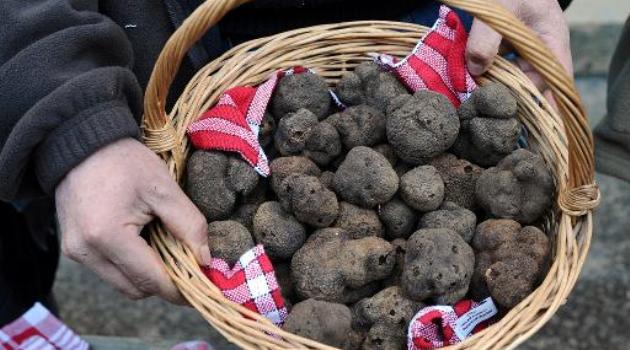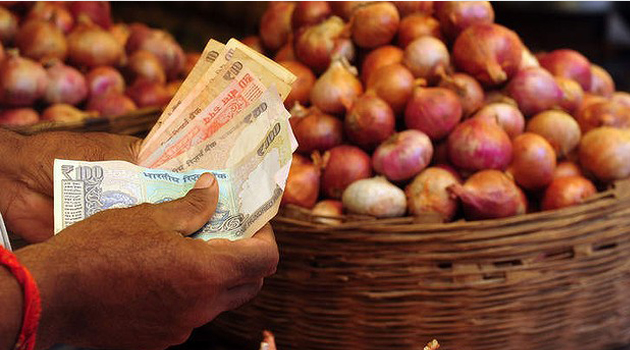
A basket of truffles is displayed as people gather in the truffle market of Lalbenque, the biggest in south-west France on December 3, 2013/AFP
PARIS, March 4- French truffle growers are up in arms over cheaper imports from China which they say are being doctored by unscrupulous chefs and passed off fraudulently as the hugely prized local variety.
The knobbly fungus, which grows around the roots of oak, hazel and lime trees, is one of the most expensive foods in the world by weight and the stakes are high in a battle for market share and gastronomic integrity.
Black French truffles, or ‘tuber melanosporum’, from the southwestern region of Perigord are known as “black diamonds” and sell for 500 euros ($680) per kilo (2.2 pounds) on average.
In comparison, the pale tuber indicum variety from China and the Himalayan foothills fetches only 30 euros a kilo.
French trufficulteurs, as the cultivators are known, allege that some eateries spray scents and chemical additives on the Asian variety and pass them off as Perigord truffles to an unsuspecting clientele.
The finest black truffles have a subtle aroma and an earthy flavour reminiscent of a rich chocolate, according to connaisseurs.
With the exception of the white Alba truffle from Italy’s northern Piedmont region, Perigord truffles are scarcer and more highly prized and priced than any others.
Truffle groves abounded in France at the start of the last century. Traditionally pigs or dogs were used to sniff them out, usually at night.
In 1900 the fungi was used by most people and far more regularly than now when it appears on tables at festive occasions and often in slivers.
But production plummeted as growing industrialisation led to a exodus to cities and the two World Wars wreaked havoc on the French countryside.
– ‘Competition from cheating chefs’ –
And therein lies the problem when it comes to identifying the difference between what the French consider to be the real deal and rivals that have benefited from culinary doping.
Once upon a time, truffles might have been piled generously into an “omelette aux truffes” or even simply pan-fried with other premium mushrooms in some butter, a touch of garlic and a handful of parsley.
Now they are so expensive that even top-end chefs are forced to use them sparingly as essentially flavour enhancers in sauces to accompany the likes of scallops, spiny lobster or the finest poultry.
With tiny flecks buried in a cream sauce like vanilla in a custard, it takes a real expert to be sure that the truffles deployed are how they are described — and that is why fraud is allegedly so widespread.
“We are competing with dishonest chefs who are using Chinese truffles and spraying them with scents without telling their customers,” said Michel Santinelli, from the French Federation of Trufficulteurs (FTT).
The FTT is calling for a campaign to educate consumers and new labelling rules which would make it clear to consumers that they were buying either genuine Perigord mushrooms, or a cheaper and inferior version.
FTT head Jean-Charles Savignac said France’s General Directorate for Competition Policy, Consumer Affairs and Fraud Control had launched an investigation in 2012 to seek out “truffles that have been treated with additives.”
Savignac said between 10 to 15 percent of the samples seized and sold as Perigord truffle were found to be of the Chinese variety that had been tampered with.
“We need a mechanism that clearly identifies Perigord truffles and other ones so that the buyer knows what he is getting,” he said.
He said a key challenge for the FTT was looking at ways to increase “structurally deficient” production in France, currently hovering at around 50 tonnes annually.
Chinese imports to France run at around 25 tonnes a year.
“We know that one needs chalky soil and a temperate climate without deep snow,” to grow truffles, said Savignac underscoring that global warming and resultant droughts had also played a role in the declining production.
“We are going to select plots in the main producing areas and plant trees near which truffles grow,” he said.
All this would be done under a protocol signed last week between the French government and truffle cultivators and France AgriMer, a national body regulating food products.
The state will provide a grant of 200,000 euros ($275,000) annually to develop the truffle industry under the seven-year agreement.
The estimated 20,000 French truffle producers have committed to plant between 300,000 and 400,000 trees annually.
But truffle lovers will have to wait for new supplies to come on stream: it takes about a decade from the time of planting for the truffles to appear.


































